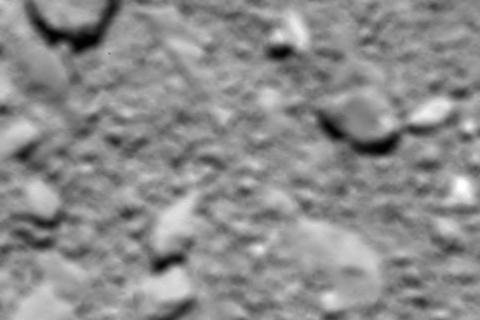1 of 6 | The last image captured by Rosetta before it crashed into Comet 67P. The image shows the comet's surface from an altitude of roughly 10 feet. Photo by ESA/Rosetta/MPS for OSIRIS Team MPS/UPD/LAM/IAA/SSO/INTA/UPM/DASP/IDA
DARMSTADT, Germany, Sept. 30 (UPI) -- Rosetta ended its mission on its own terms -- or at least the scientists and engineers that controlled the probe did.
On Friday morning, the European Space Agency craft purposefully crashed into Comet 67P/Churyumov–Gerasimenko, ending in dramatic fashion what was a historic mission. The relatively gentle collision was proceeded by a 13-hour free fall.
The probe was able to transmit several images of its final approach back to mission headquarters. Rosetta also collected low-altitude gas, dust and plasma measurements while falling toward the comet.
"Rosetta has entered the history books once again," Johann-Dietrich Wörner, ESA's director general, said in a news release. "Today we celebrate the success of a game-changing mission, one that has surpassed all our dreams and expectations, and one that continues ESA's legacy of 'firsts' at comets."
Rosetta joins its history-making companion on the surface on Comet 67P. Last year, the lander Philae became the first craft to successfully touch down on a comet. Despite its safe landing, the lander bounced into a crater and lost battery power three days later.
While Philae's scientific efforts were short-lived, Rosetta collected a wealth of scientific data while orbiting the comet, offering scientists insights into the evolution of the solar system.
Rosetta discovered molecular oxygen and nitrogen streaming from the comet's nucleus, and also found significantly higher levels of heavy water than is found on Earth, suggesting Earth's water originated from sources different from those that supplied Comet 67P with its water.
Rosetta launched in 2004. Over its last 12 years in space, it has circled the sun nearly six times and logged nearly 5 billion miles.
"The mission has spanned entire careers, and the data returned will keep generations of scientist busy for decades to come," said Alvaro Giménez, director of science at ESA.















